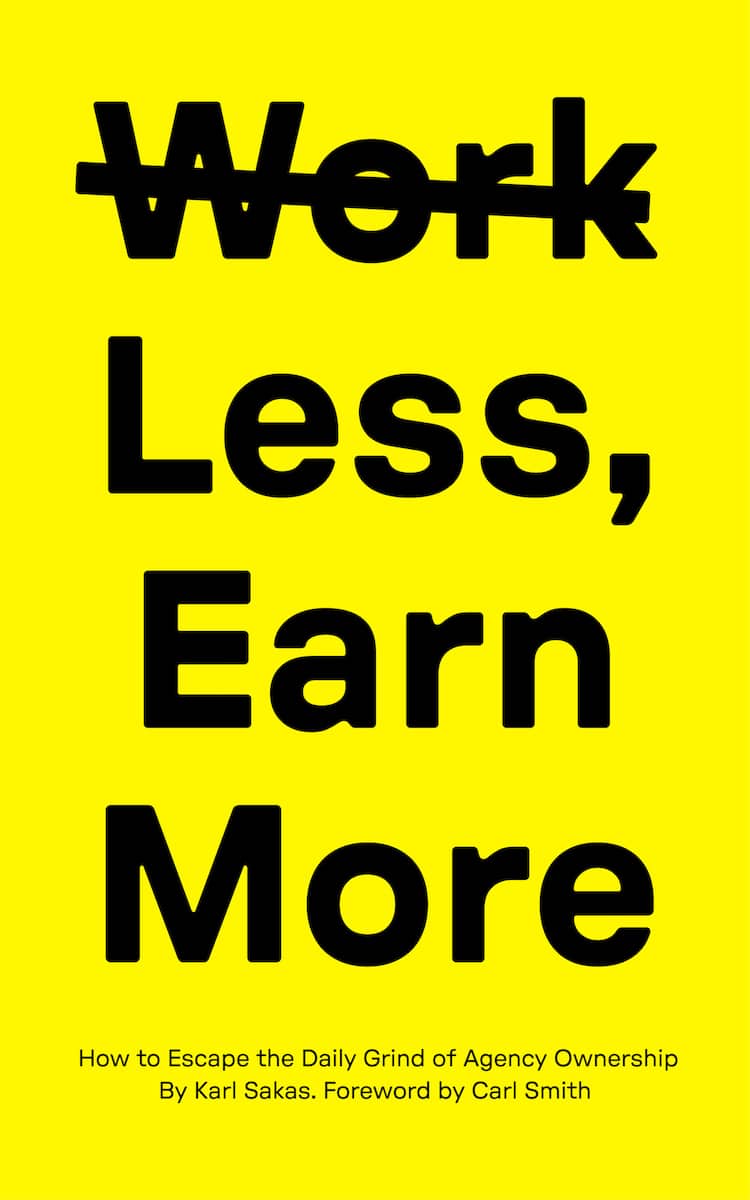Hiring a #2 can be daunting, and rightly so. As an agency owner, this key role will make or break your ability to spend less time working and more time doing what you love.
In order to find the right fit for your #2, you first need to define the role: what is the scope of their job, and what are the mandatory qualifications for them to succeed at your agency? (See my previous article for advice on your #2’s job title.)
Figure this out before you begin recruiting. Why?
Getting it done before you begin the search process will set you up for a smooth hiring and onboarding process. And the sooner you outline these steps, the sooner you get to wrap up training your #2—and take steps towards making yourself Optional.
In this article, we’ll review how to define what you need in a #2. The goal is to help you write an internal job description that accurately captures what you do and don’t need. (You can also get my free Agency COO Job Description template.) Then you can translate that into a public job posting and start the active hiring process.
Let’s start by looking at the scope of the role. (Not sure whether you need a #2 yet? Here’s how you can tell—and what that might look like for you.)
Your #2: Line vs. staff roles
To begin, you’ll want to consider whether what you’re looking for is a line role or a staff role.
- “Line” roles oversee employees doing profit-generating work—for instance, delivery or sales.
- “Staff” roles oversee internally-facing admin functions—for instance, accounting or HR.
In this article, we’re focusing on “line” roles—that is, a formal #2 who oversees a majority of employees at an agency (aside from the CEO and, typically, the sales and marketing team members).
If your Head of Operations is only overseeing internal operations—and not managing the majority of staff—that’s OK… but they’re not a formal #2. If you’re looking for an informal #2, you might consider hiring a senior Executive Assistant or Chief of Staff instead. I’ll review informal #2 roles in a future article.
Defining the scope for your #2’s job
The scope of the job drives the job description, which drives whether you hire the right person. There are a few ways you might look at structuring the responsibilities of the role:
- Overseeing delivery only (e.g., account management, project management, SMEs, client strategy)
- Overseeing delivery and internal operations (e.g., delivery, HR, and accounting)
- Overseeing all areas except Growth (e.g., everything except marketing and sales)
Whatever you choose to have them oversee, be sure you’re delegating responsibility rather than abdicating. How can you tell the difference?
- When you delegate, you’re giving your #2 all the tools and support they need to be successful—yes, that includes being available for check-ins. Once you’re #2 is fully trained, check-ins don’t need to happen every day or every week, but they should happen on a regular and predetermined schedule that works for both of you.
- When you abdicate, you’re essentially telling your #2 to “just figure it out” on their own… Or you’re ignoring something that you should be handling, but not expressly giving your second-in-command permission (or the tools they need) to take care of it themselves.
That last part goes both ways—delineating what your #2 shouldn’t be handling will help reduce confusion, chaos, and drama in the long run.
What prior experience should you require from a #2?
Ideally, the person you hire should have experience in this exact role at other agencies. It’s always risky to hire someone who has no experience as a #2.
- Experience as a #2 at a smaller agency could work—just bear in mind that someone in this position may not be able to predict the problems they’ll see at your agency.
- You may even consider hiring someone who was the second-in-command to the #2 at a bigger agency. The downside? They likely weren’t covering the same scope of work as they would be for you. In this case, you may need to provide additional training and support.
The reality is, you won’t always find a perfect match when you’re recruiting—that’s where knowing what you’re looking for and having a solid onboarding and training plan in place will come in handy. Before you begin recruiting, you should decide what your “must-have” qualifications are versus your “nice-to-have”s.
Here’s how I’d prioritize what to look for, with an eye toward their prior experience:
YES (consider them)
- Agency operations leadership experience (e.g., they’re currently the COO at a smaller agency or the VP of Operations at a larger agency)
- Ideally, they’ve done this before for someone else—whether a similar role at a similar agency, or perhaps a smaller role at a bigger agency.
- You might consider someone who was a CEO at a smaller agency… but be skeptical here. Why do they want to be your #2, when they’re currently their own boss? If they just don’t like sales, but enjoy managing operations and delivery, this could be a good fit. But if they don’t like managing people, it’s not a match.
- Agency operations experience (e.g., they’re currently a Director of Operations, Director of Production, or Senior PM who has demonstrated interest in focusing on operations)
- You might consider hiring someone who is (or was) a VP of Client Services or VP of Account Management… if they’re detail-oriented enough.
- You might consider hiring a Chief of Staff or Executive Assistant, if there’s a ramp-up plan for them to grow. They know a lot of the decisions the owner makes—but be sure to get clarity on whether they understand the difference between leading versus supporting. That is, they’d now be in a “line” role, not a “staff” role.
MAYBE (proceed with caution)
- Leadership OR management experience, but NOT at an agency (e.g., they’re currently #2 at a non-agency)
- You might consider someone with this kind of experience over someone who’s worked in a non-leadership role at an agency. To an extent leadership and management are transferable skills. But…
- You’ll have an easier time hiring a high-potential agency operations person and creating a ramp-up plan that prepares them for leadership. Why? They’ll understand the work they’re overseeing, rather than managing in a vacuum.
NO (this will almost certainly go poorly)
- Agency experience, but no operations experience (e.g., they’re currently a strategist, salesperson, or account manager at another agency)
- To be considered, they should have demonstrated interest in operations at another agency. Even so, it’s a big risk giving someone their first agency operations leadership role at such a high level.
- If you’re not in a rush to hire a #2 and feel you’ve found the perfect potential fit here, I’d recommend starting them out at in a lower role—maybe as an informal #2—with a potential ramp-up plan that eventually gets them to becoming your formal second in command.
- Experience doing the work your agency does (e.g., they currently are an in-house marketer)
- They haven’t worked in agencies or in a leadership role? Nope.
- Experience in your client industry or industries (e.g., they don’t have agency or leadership experience)
- They might be a good match as a strategist, but not as your future COO or other #2.
Decide where to draw the line. If you need someone to ramp-up quickly, find someone who’s done a similar job before… and ideally, who’s done it more than once before.
Creating the job description for your COO or other #2
Note that job descriptions are not job postings. The following advice is for internal purposes; your external marketing copy will look slightly different. More on that in a future article—and in the meantime, get my free COO Job Description template.
In writing the job description for your #2, these are the pieces you’ll want to focus on:
- The right job title: Some options for #2 include President, COO, Managing Director… and more.
- Keep in mind that the title you choose for your #2 should be relative to yours, and carefully considered as part of the ramp-up plan for the role. For example, if you’re the President or CEO, you might hire a COO as your #2—with the goal to ramp yourself up to Chair and them up to President (and eventually CEO).
- For more on this topic, see my first article on hiring a #2.
- Their priorities: No one can juggle everything at once, so you’ll need to prioritize.
- To help you prioritize what’s most critical in this role, consider: What might get this person promoted? What might get them fired? What are the KPIs (Key Performance Indicators) that you expect them to fulfill?
- Put their responsibilities in order of importance (or, at minimum, pick the top 3-5 responsibilities and separate them out from everything else they should be doing).
- Compensation: I’ll elaborate more on this in a future article in this series, but for now, keep in mind that the responsibilities and the job title you choose will signal a certain level of compensation. For example:
- If you’re hiring a VP or COO and not offering a six-figure base salary… you’re not going to attract high-quality candidates.
- If you don’t include profit-sharing and/or some form of equity, you likely aren’t going to find a COO or Managing Director who’ll step in to eventually replace you as CEO (if that’s the direction you want to go in).
- Get feedback: Don’t decide in a vacuum.
- You want to get perspective from your current leadership team and from outside advisors before you invest time and energy in posting the job.
- But be forewarned that there’s a morale risk here—if you have internal staff who believe they should be considered for the job (but you don’t think they’re qualified yet), they may not take this request well. And indeed, passed-over employees tend to leave.
Now, put that all together to create that job description! Want a head start? Download my FREE Agency COO Job Description template here.
Get More Advice on Finding Your Agency’s Ideal #2
Want to hire someone who can run your business without constant support? Define the role correctly, before you post it. Otherwise, you might hire the right person… for the wrong role.
This post is the second in a new series on hiring a second-in-command to run your agency. Over the next few months, I’ll share more articles on the topic—including how to find your #2, what to pay them (including base compensation and incentives), ramp-up plans, and more.
Don’t miss updates—get my newsletter for agency owners. And if you want my 1:1 advice on hiring a #2, let’s chat.
QUESTION: What duties are you ready to hand off to make yourself more Optional at your agency?


